This post may contain affiliate links. If you make a purchase through an affiliate link, I will earn a commission at no extra cost to you. Thanks for your support.
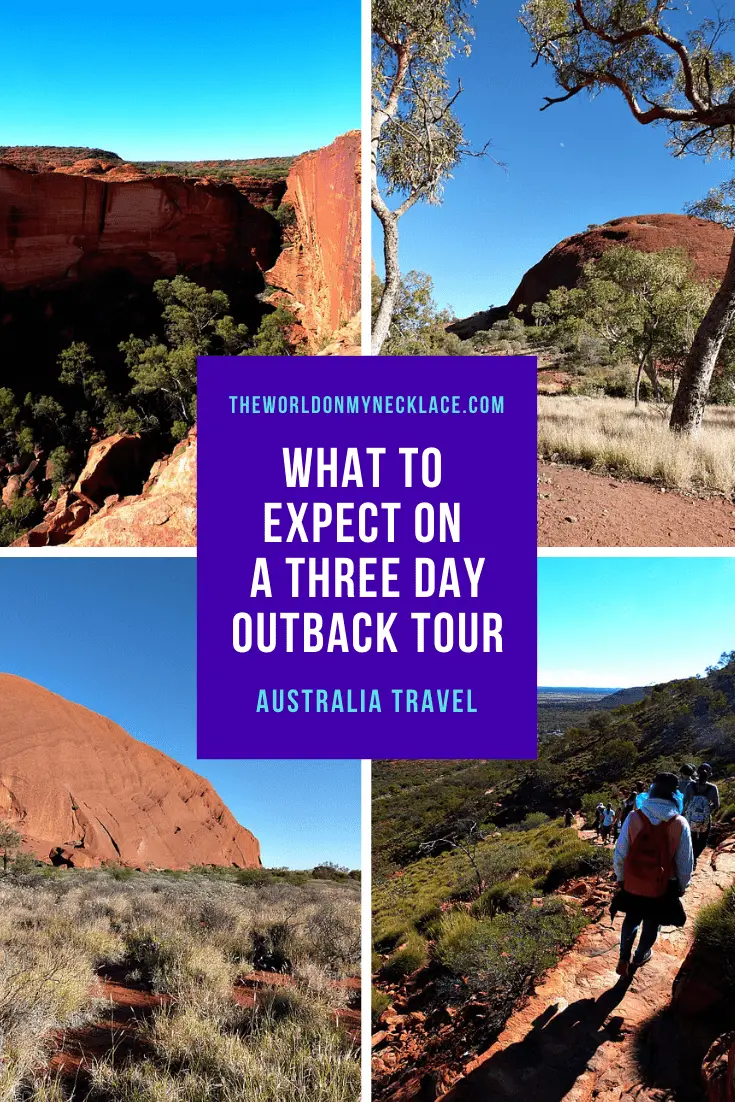 I did a 3 day Uluru tour to Uluru, Kata Tjuta and Kings Canyon, and it was a great introduction to the Australian Outback. Here is what to expect on a 3 day Uluru camping tour…
I did a 3 day Uluru tour to Uluru, Kata Tjuta and Kings Canyon, and it was a great introduction to the Australian Outback. Here is what to expect on a 3 day Uluru camping tour…
Uluru is a giant, red rock in the middle of a desolate desert. And I can’t say that the thought of seeing it provoked a huge amount of excitement in me.
Sure, it’s kinda cool, but there were other places in Australia that were much higher on my bucket list, like Tasmania, the Whitsundays, Lord Howe Island, and the Daintree Rainforest.
They are green. They aren’t dusty. And I really love green.
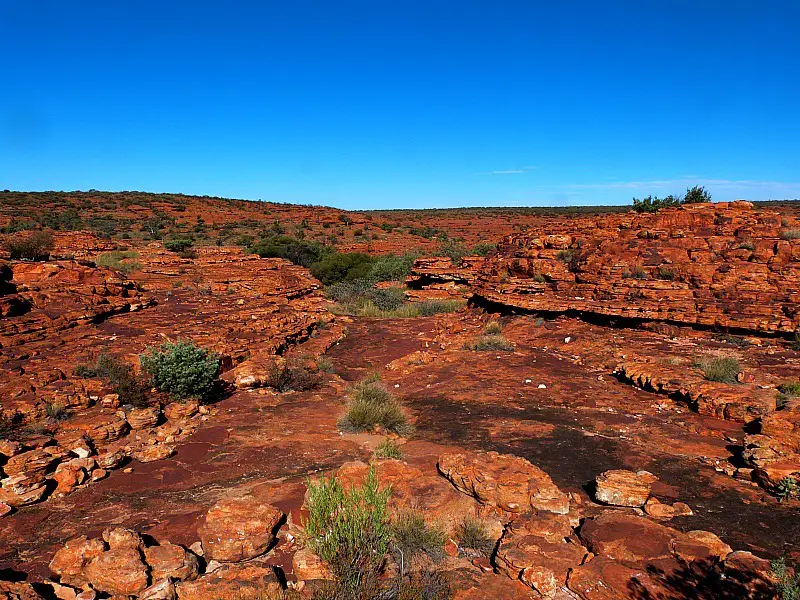
You see, I have never really been that into desert landscapes, and that’s pretty much what surrounds this gigantic monolith.
But, because my brother Robbie got a job as a tour guide out there, I thought it was a good a time as any to go and see this giant rock that everyone gets so excited about.
Robbie worked for The Rock Tour, a backpacker-oriented trip that starts at Uluru and finishes in Alice Springs and takes in Kings Canyon, Uluru (Ayers Rock), and Kata Tjuta (the Olgas) over three days.
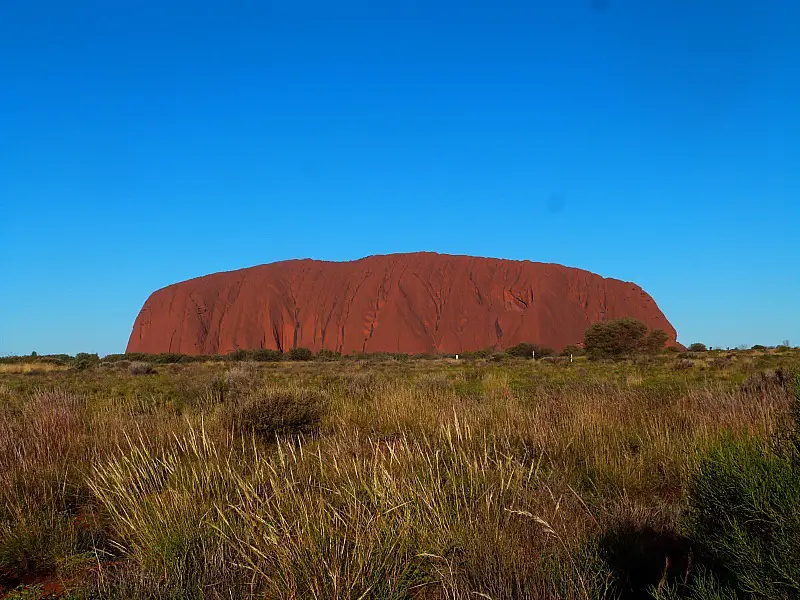
It involves sleeping under the stars in swags (canvas sleeping sacks), lots of hiking, long days, early starts, and hours of driving. It was a lot cheaper than I thought it would be, one of the cheapest outback tours you can do, and I even got a small family member discount.
So along with the free accommodation before and after the trip (on a mattress on the floor of Robbie’s apartment); I had myself a relatively cheap holiday.
Well, cheap for Australia.
NOTE: When I did the tour in 2014, the tour started and ended in Alice Springs and went to the attractions in reverse order to what they now do. You can now start in Alice Springs or Uluru.
I have adjusted this itinerary to reflect these changes to the tour and to help you better understand what to expect on your own Uluru tour if you are doing it one way from Uluru to Alice Springs.
Doing the trip one way will mean a lot less time driving, and will allow you to spend a few days in Alice Springs before moving on to your next destination.
3 Day Uluru Camping Tour: What to Expect
Uluru Tour Day One: Uluru
After getting picked up at the airport or your hotel, you will meet the group you will be traveling with and your guide over lunch, and then it’s time for the first stop on your Uluru Tour: The Uluru-Kata Tjuta Cultural Centre.
I had my first glimpse of Uluru as we were driving there and a small jolt of excitement coursed through me. I didn’t expect to be so spellbound but I think that, like Machu Picchu and the Eiffel Tower, Uluru is such an iconic sight, and I was transfixed despite myself.
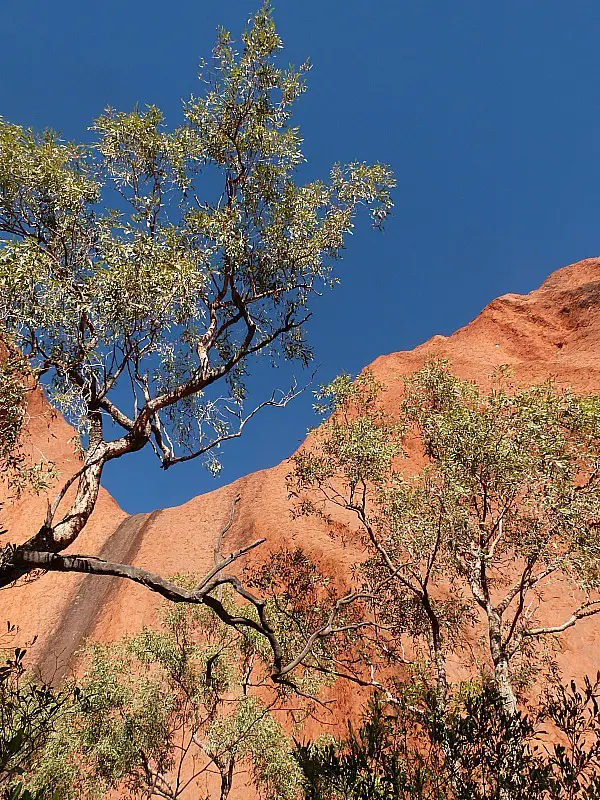 The Cultural Centre was fascinating. I watched a film that showed a re-enactment of the first contact that the native aboriginal people, the Anangu, had with the white man.
The Cultural Centre was fascinating. I watched a film that showed a re-enactment of the first contact that the native aboriginal people, the Anangu, had with the white man.
There was also a sorry book, where people had taken rocks or sand from around Uluru and suffered misfortune afterward because of it.
A lot of the souvenirs were returned along with letters apologizing for taking them and detailing the bad luck that had befallen them. I saw a similar book at the Petrified Forest in Arizona.
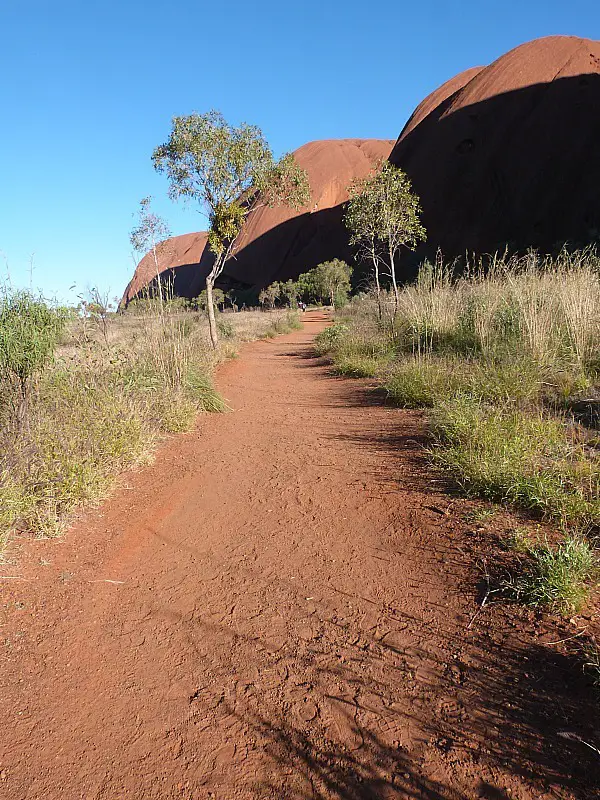
After the Cultural Centre, it was time for the main event: Uluru!
Climbing to the top of Uluru was banned in 2019, and I am so glad that they did that because it was extremely disrespectful to the Anangu people, who see Uluru as a very sacred place.
It is also very damaging to the natural environment as there were no toilet or trash facilities at the top. If anyone did their business or dropped their trash once they were up there, the refuse will end up running down the side of Uluru into water holes, contaminating them and risking the health of the wildlife that drink from there.
The continuous footsteps of people walking the same path over the last 50 years have also damaged the rock face. You see Uluru isn’t actually red, it is an off-white color.
The red color that we see is actually just surface rust from iron particles in the rock. The rock is worn down to the original color where people have been walking on it.
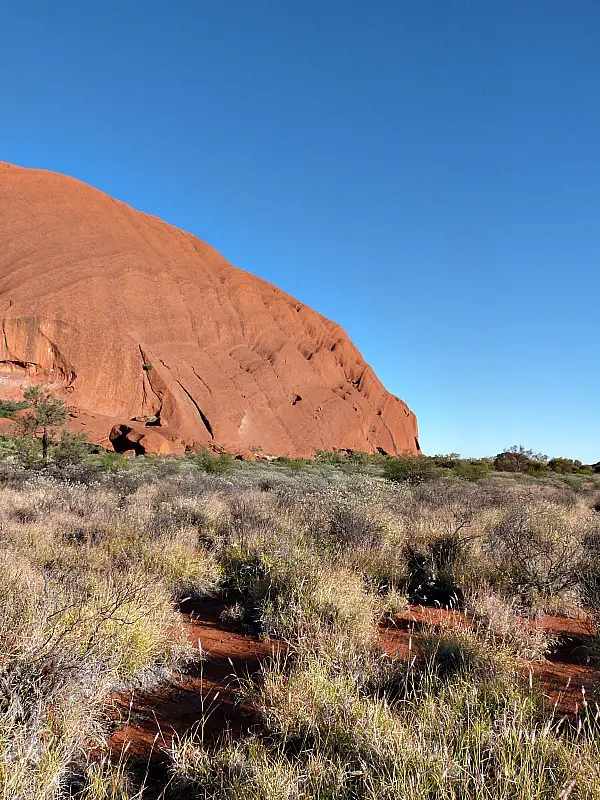 The best way to truly appreciate this wondrous rock is to walk around it and marvel at the brilliant color and sheer size of the thing, as well as the deep valleys, awesome caves, and random trees growing out of it.
The best way to truly appreciate this wondrous rock is to walk around it and marvel at the brilliant color and sheer size of the thing, as well as the deep valleys, awesome caves, and random trees growing out of it.
The base walk took two hours and I found it continuously captivating; it looked different from every angle and afforded endless opportunities for beautiful photos. I was amazed at how much it looks like a mountain range with its many valleys and caves.
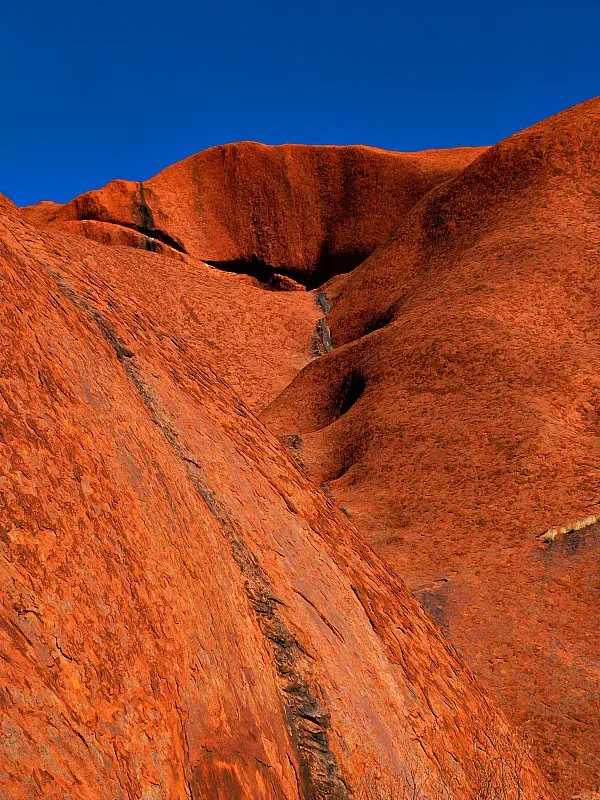
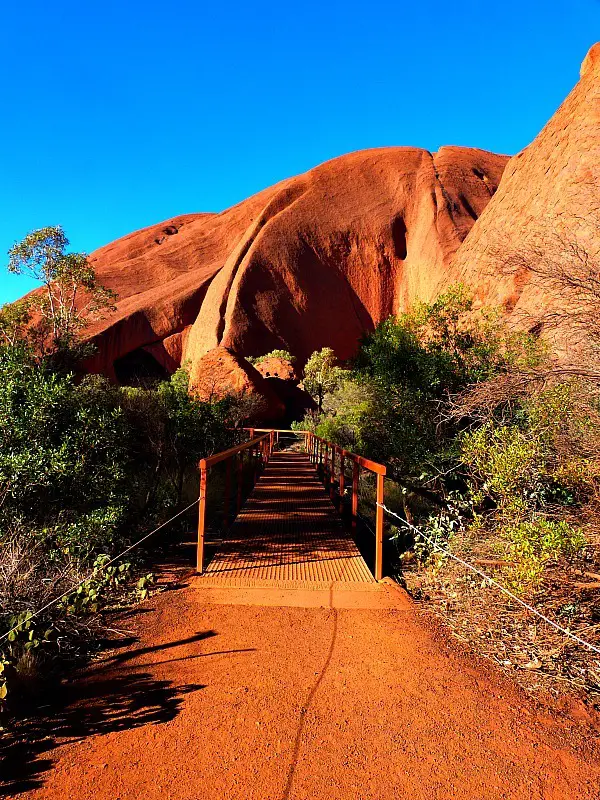
Up close you forget that it is one big rock as there are so many grooves and angles that you don’t notice when viewing it from further away.
We saw some caves with rock art and sacred sites where we weren’t allowed to take any photos. There are men’s sites and women’s sites with men not even being allowed to look in the direction of the women’s sacred site, let alone visit it, and vice versa.
This is only within their own culture though and we were told that they don’t mind men and women of other cultures seeing the sacred sites.
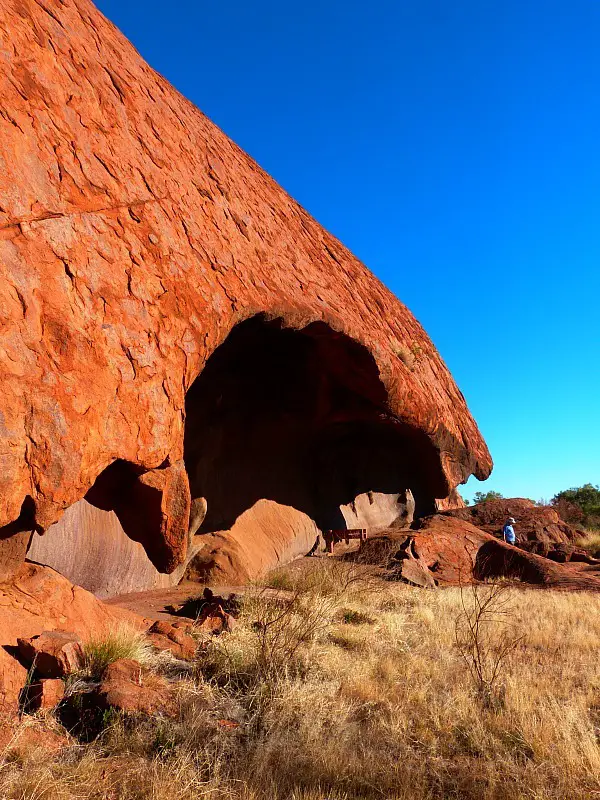
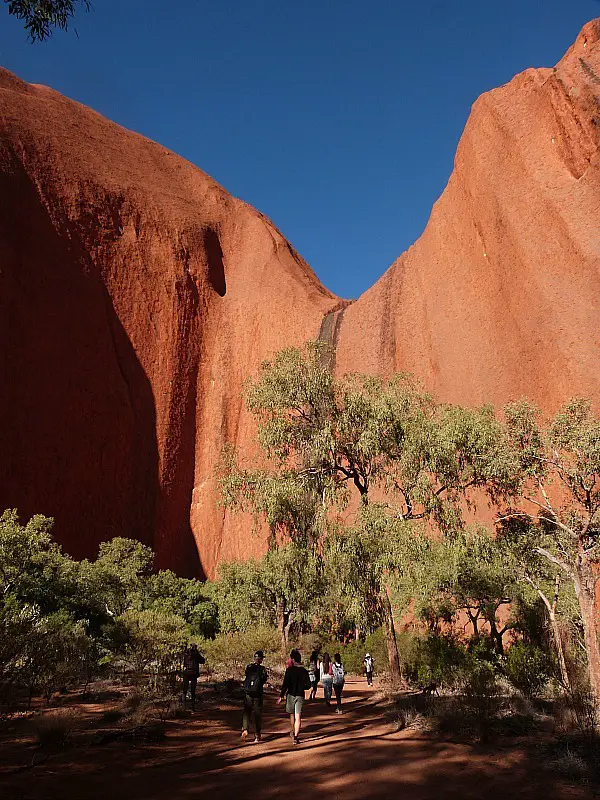
It is a profound place that exudes a powerful aura. It is almost as if you can feel the millions of years of history enveloping this ancient site.
Along with walking around the base, we did a guided walk on the short Mala Walk. This walk follows partly around the base of Uluru, and we were told some of the Anangu stories about the creation time as we walked.
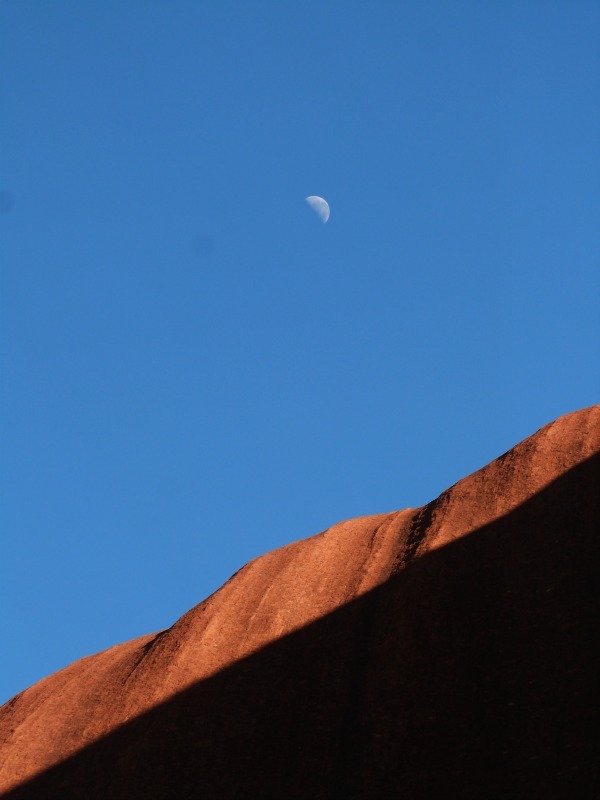 There isn’t a lot known about what Uluru and Kata Tjuta means to the Anangu. They are actually quite secretive about their culture and have only shared a few vague stories with people outside of their tribe.
There isn’t a lot known about what Uluru and Kata Tjuta means to the Anangu. They are actually quite secretive about their culture and have only shared a few vague stories with people outside of their tribe.
Some of the caves that we were shown had aboriginal rock art. The Anangu would paint over old art continuously so it is hard to date it.
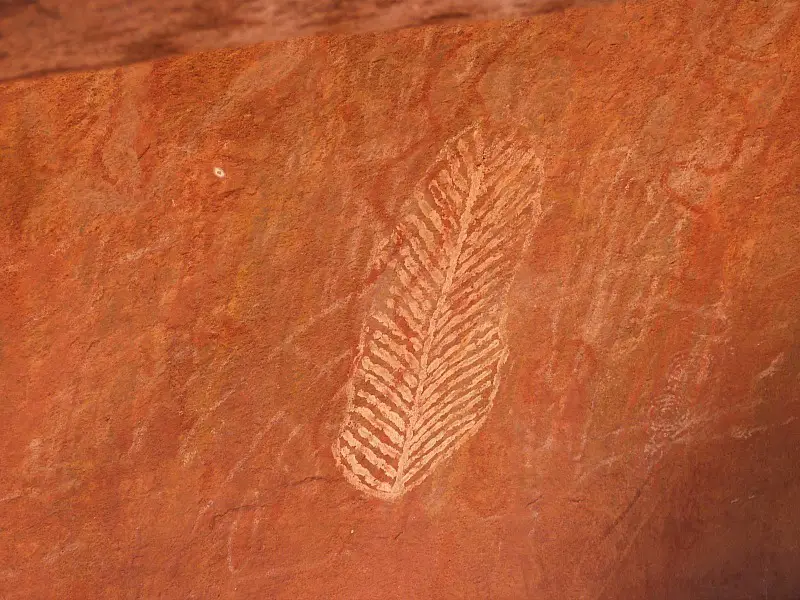 My favorite part of the walk was the shaded waterhole surrounded by a grove of trees. It was very peaceful and I sat there for a while; soaking up the silence.
My favorite part of the walk was the shaded waterhole surrounded by a grove of trees. It was very peaceful and I sat there for a while; soaking up the silence.
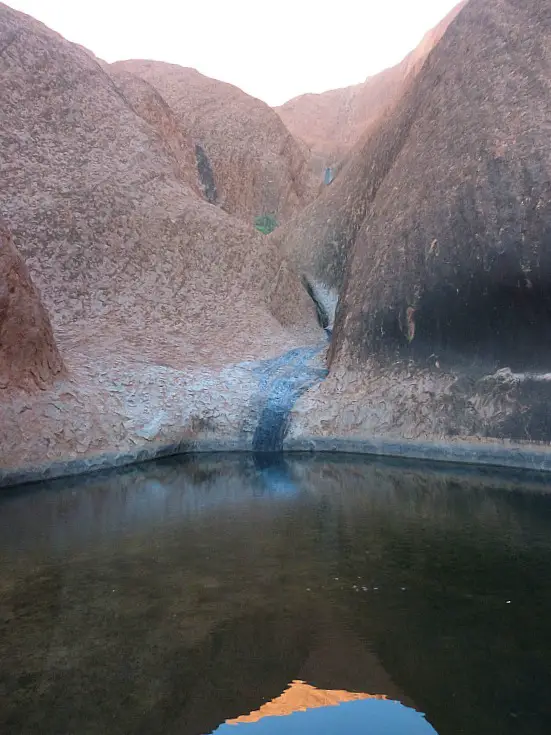 Our first dinner together as a group was at a viewpoint over Uluru, where we watched the spectacular sunset over the massive monolith.
Our first dinner together as a group was at a viewpoint over Uluru, where we watched the spectacular sunset over the massive monolith.
As the sun set and the sky blazed purple and orange, Uluru was lit up a glowing red; like a hot ember surrounded by psychedelic fire.
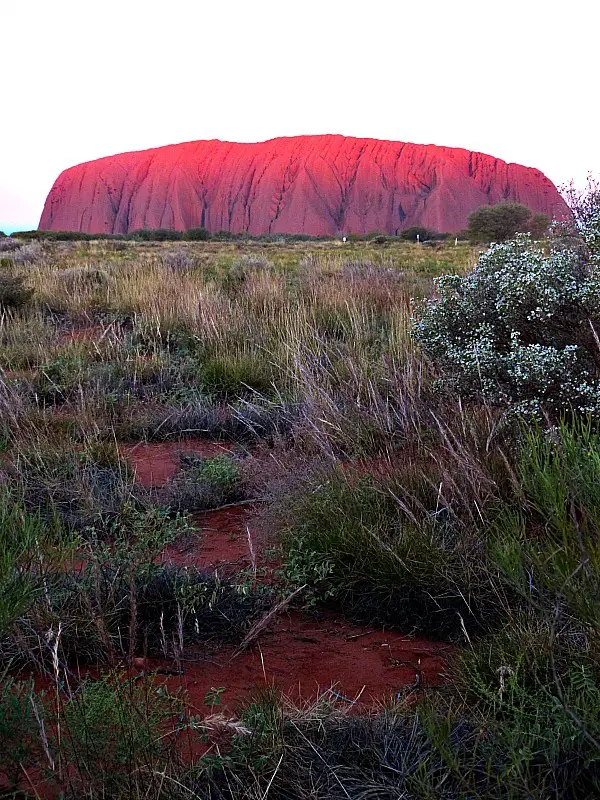
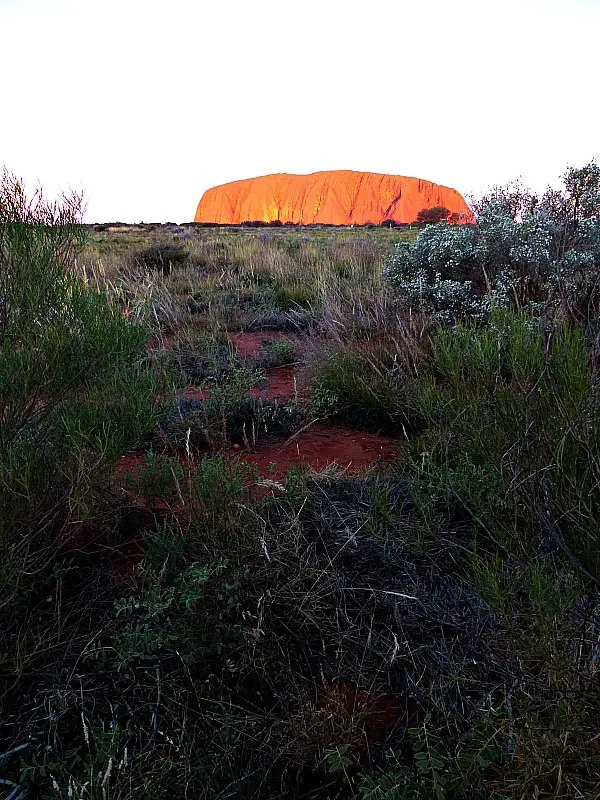
A sight I will always remember, and a massive highlight of my 3 day Uluru tour.
After the sunset, there was a buzz of energy coursing through the group. We drove to our campsite and a group of us walked to a nearby viewing platform to get a good view of the stars.
The Milky Way struck a bright pathway across the night sky and we saw thousands of stars. I am always in awe when I see a sky like that.
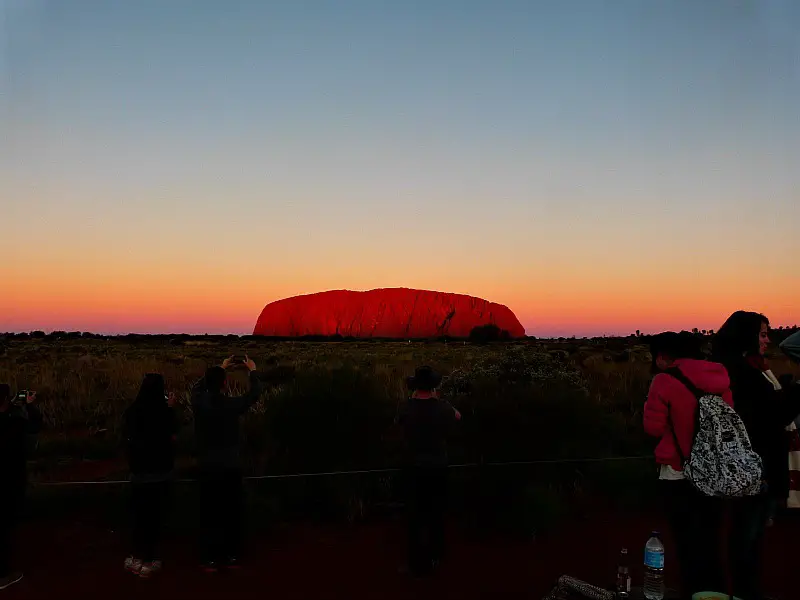
The night was so cold and rather uncomfortable. Winter is definitely a nice time to visit the red centre with temperatures not rising much above 20 C/68 F in the daytime, but at night it can drop down to freezing.
I’m pretty sure the temperature was hovering around there, and I don’t think I slept more than an hour or two.
Uluru Tour Day Two: Uluru and Kata Tjuta
We were roused by Robbie at 5.45 am to drive to the viewpoint over Uluru that we had been to the night before; this time to watch the sunrise.
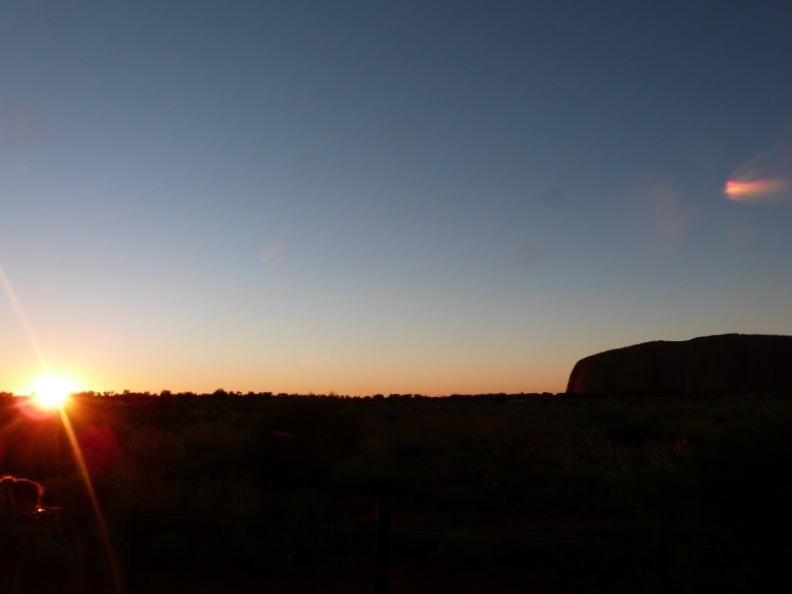 It was so, so cold.
It was so, so cold.
The sunrise was not as spectacular as the sunset the night before but it was still probably one of the most scenic breakfasts I have had in my travels.
Not a bad way to start the day although I didn’t get any feeling back in my toes until well after the sun rose.
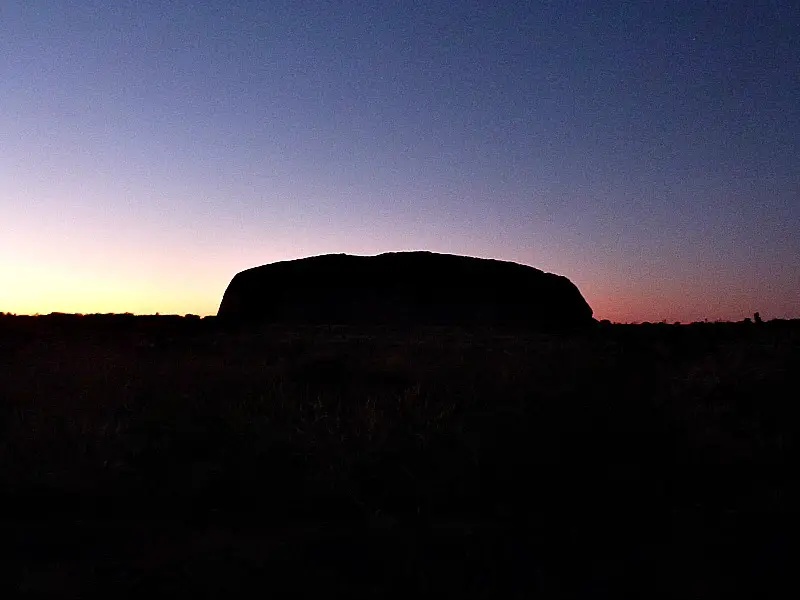
Then it was time to say goodbye to Uluru and hello to Kata Tjuta!
Kata Tjuta is a group of 36 domed rock formations, 30km from Uluru, and part of Uluru-Kata Tjuta National Park. Like Uluru, it is believed that the domes of Kata Tjuta were in fact one rock that has weathered and split over time but still joined below ground.
If Kata Tjuta is considered to be one rock, then it would be a lot larger than Uluru, which claims to be the largest rock in the world (this is a disputed title with Mt Augustus in Western Australia).
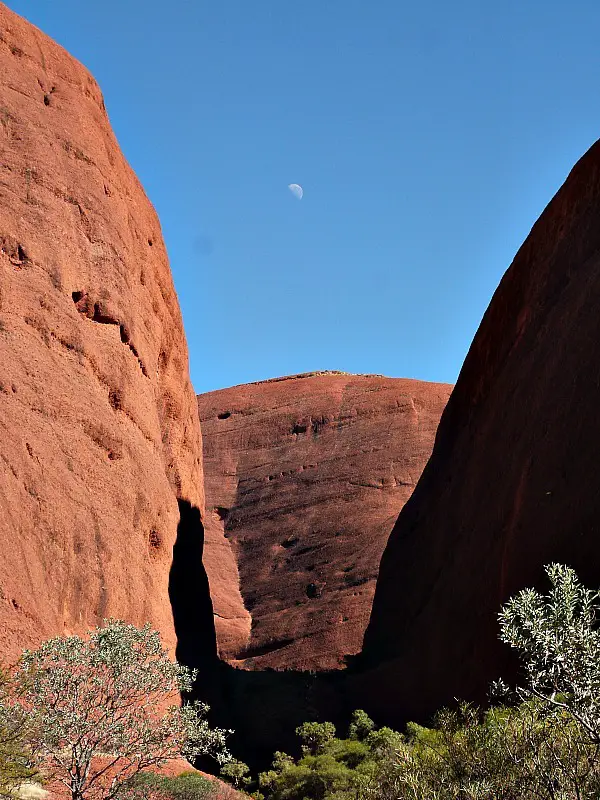
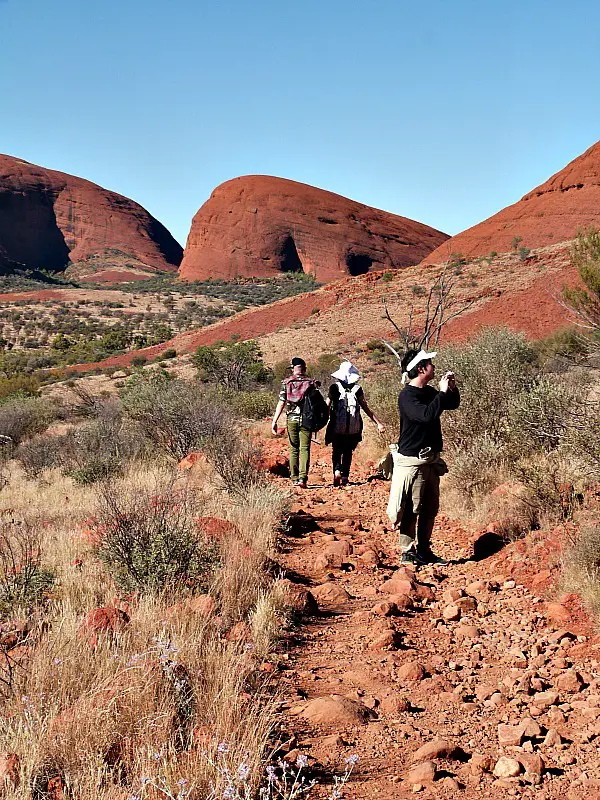
We did the 7km Valley of the Winds walk which loops around the striking sandstone rock formations, along a path lined with scrubby trees and terracotta-colored sand. A kangaroo hopped past us as we wound our way along the rocky path.
Between two of the giant rock mounds, we rose up a switch-backed path to a stunning viewpoint over the surrounding scenery and the wide-open spaces.
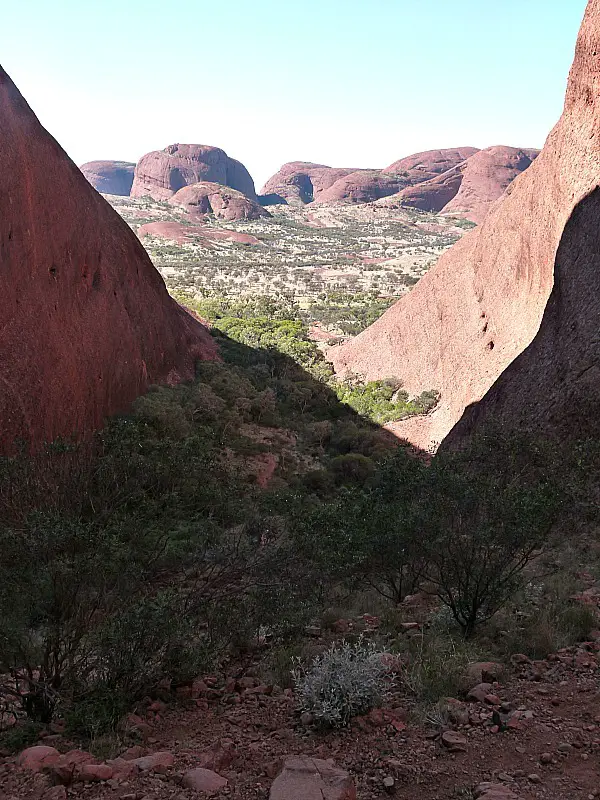 There is definitely a sense of freedom that permeates your senses in the outback.
There is definitely a sense of freedom that permeates your senses in the outback.
My brother prefers Kata Tjuta to Uluru and I can see why. The rock formations are unusual and very picturesque.

After lunch, is the drive to Kings Canyon, stopping at Curtin Springs Cattle Station along the way.
We passed dusty red earth, long wheat-colored grass waving in the wind, and dead trees with sun-blackened trunks. I was surprised by how many trees there were.
The lower part of the Northern Territory which encompasses Alice Springs, Kata Tjuta, Uluru, and Kings Canyon is actually classed as semi-arid, rather than desert as there is a high water table and higher rainfall here.
This supports plant life, unlike the red sand deserts in other parts of Central Australia.

On this long drive, we were told more about the area.
One of the people that we were told about was Harold Bell Lasseter. Back in the early 20th Century, Lasseter made claims of discovering a vast gold reef in a remote area of the Outback.
After trying many times without success, Lasseter finally received private funding to mount an expedition to go in search of the gold in 1930.
The expedition suffered a string of bad luck including a plane crash, trucks being unsuitable for the terrain, and an increasingly vague and difficult Lasseter.
They finally reached the spot where Lasseter said the gold would be, and it wasn’t there.
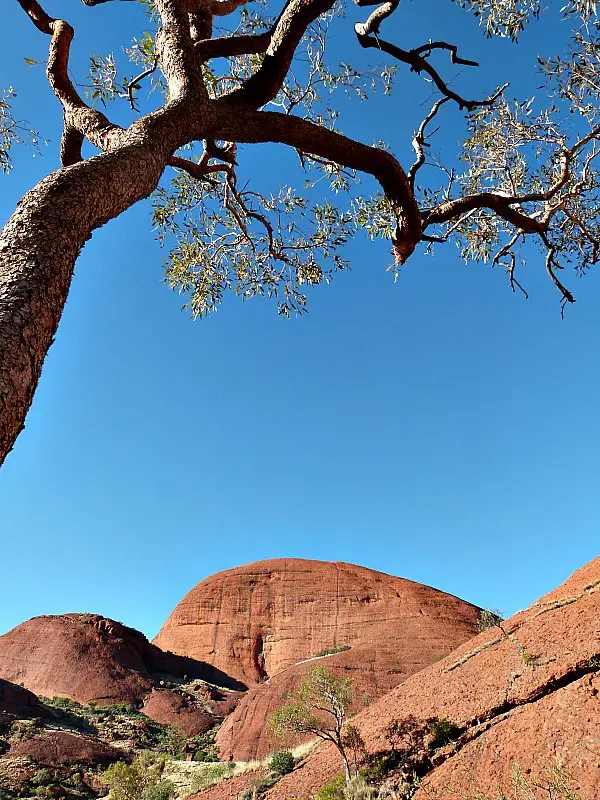
He was quick to change his story, claiming the reef was 150 miles further south. The rest of the Expedition was fed up at this point and accused him of being a charlatan. They left him to it.
Lasseter ended up starving to death after his camels ran away, despite the offer of food and water by the local aboriginal people. He refused to eat the bush tucker that they offered him as he thought they were trying to poison him.
So Lasseter’s fabled reef is Australia’s own El Dorado. Some people still think it is out there somewhere.
We stopped to collect firewood on the side of the road then drove to our basic bush camp where we would be spending our second night in swags under the starry night sky.
Robbie cooked dinner in a Dutch oven and a giant wok over the hot coals of the fire, including some amazing damper bread.
He also cooked an Anangu specialty, kangaroo tail, for people to try. I didn’t try it myself but I was told that it tastes like fatty lamb.
Everyone had drinks and ate dinner around the warmth of the fire, before rugging up in our sleeping bags and swags for the evening.
There were so many stars, and it was a lot warmer than the first night.
Uluru Tour Day Three: Kings Canyon
The first thing I saw when I woke up in the morning was a small dingo running away from the campsite. Apparently, there are a lot of them around but they are scared of people (unlike the pests on Fraser Island) and they aren’t dangerous.
After breakfast, we eagerly headed to Kings Canyon nearby, the last major stop on our 3 day Uluru camping tour.
And Kings Canyon is simply spectacular.
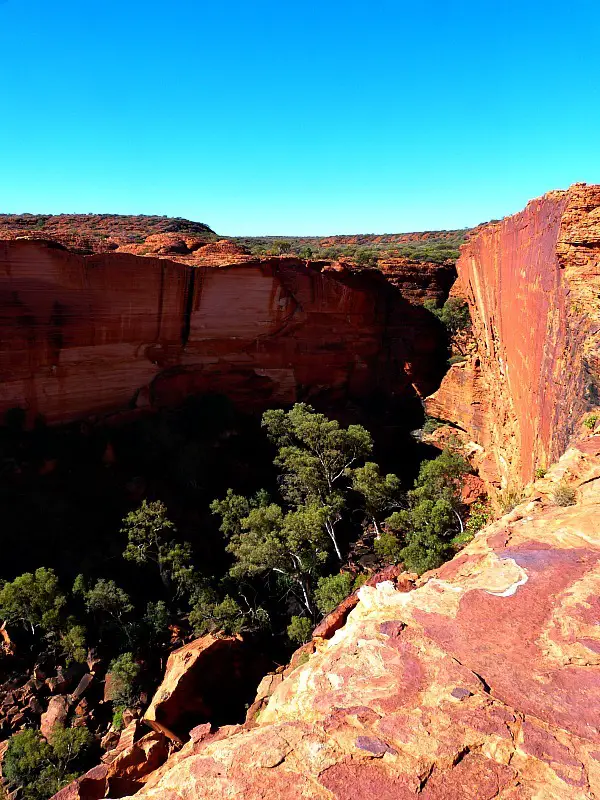 Impressive red sandstone cliffs drop steeply to the rock-strewn canyon floor. We hiked the rim trail, with the first part of the hike including a struggle up Heart Attack Hill a rather steep set of switchbacks that had to be tackled in order to reach the canyon rim.
Impressive red sandstone cliffs drop steeply to the rock-strewn canyon floor. We hiked the rim trail, with the first part of the hike including a struggle up Heart Attack Hill a rather steep set of switchbacks that had to be tackled in order to reach the canyon rim.
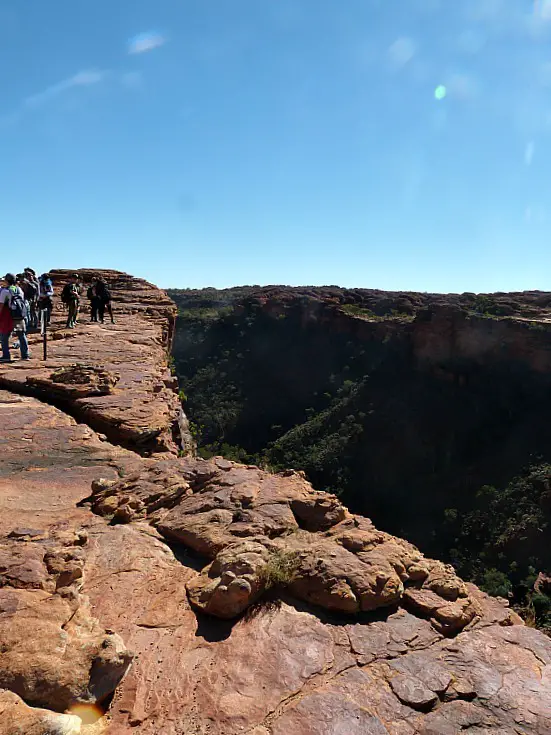 It was a hot, tiring walk and I couldn’t imagine doing it in the heat of summer when it would be 20 degrees hotter. A few people have died of heart attacks and heat exhaustion upon climbing the hill, hence the name.
It was a hot, tiring walk and I couldn’t imagine doing it in the heat of summer when it would be 20 degrees hotter. A few people have died of heart attacks and heat exhaustion upon climbing the hill, hence the name.
The hike was very scenic with the beautiful rich colors of the canyon contrasting beautifully against the brilliant blue sky. It gave me the shivers looking over the edge of the rim; impossibly high above the canyon bottom.
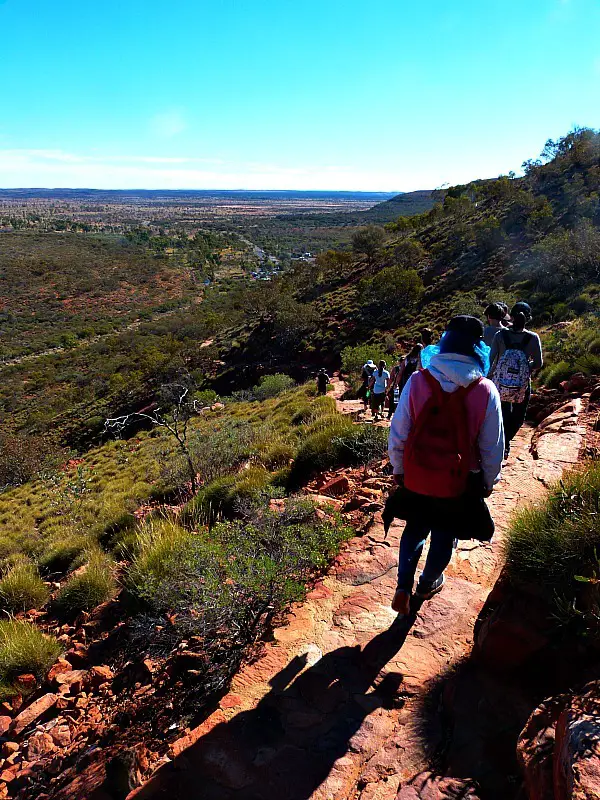 One section of the hike is known as the Garden of Eden and is lush with greenery. A natural spring-fed waterhole is surrounded by trees and ferns, creating an oasis in the red rock landscape.
One section of the hike is known as the Garden of Eden and is lush with greenery. A natural spring-fed waterhole is surrounded by trees and ferns, creating an oasis in the red rock landscape.
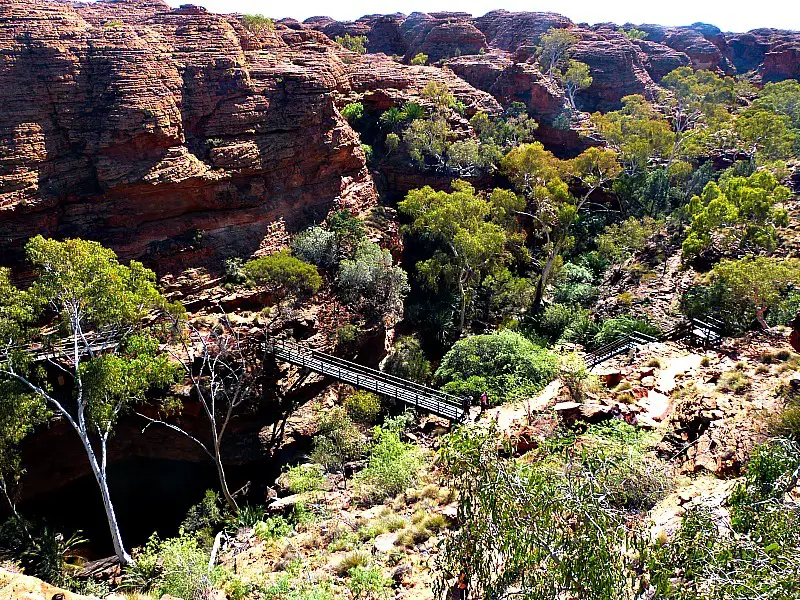 Robbie guided us on the two-hour walk and pointed out things along the way such as the poisonous rock mint, which some of the local aborigines would use to hunt.
Robbie guided us on the two-hour walk and pointed out things along the way such as the poisonous rock mint, which some of the local aborigines would use to hunt.
They would use it to poison the water in the water holes that animals would drink at, then kill them in their weakened state. Doing this was against Aboriginal Lore and there were punishments if you were caught.
One of the punishments was embedding a poisonous wood spear tip in the leg of the offender. That sounds bad enough but the worst punishment was being temporarily blinded by the sap of the Ipi Ipi plant, then being led into the desert and being left there with no provisions and no sight to fend for themselves.
In most cases, they would perish but if they somehow managed to survive and make it back to their tribe, it was the will of Tjukurpa and the punishment was over.
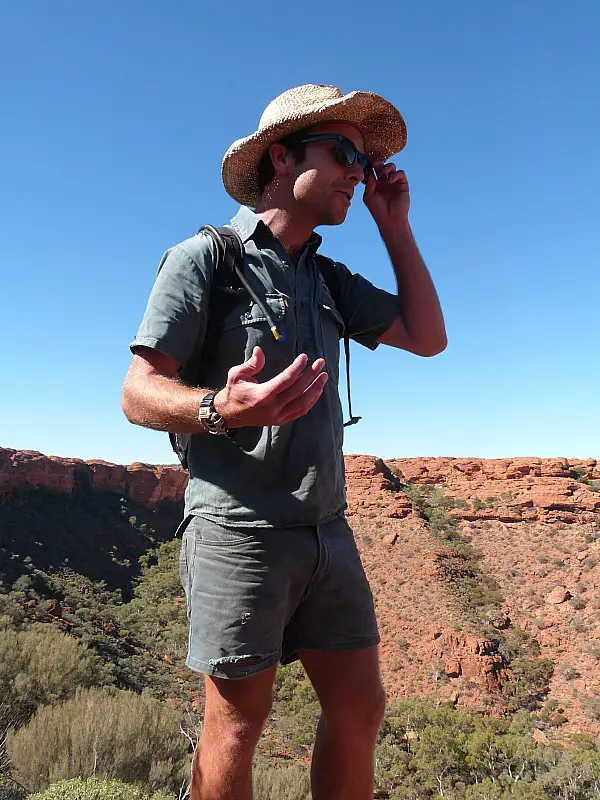 Tjukurpa is the word that the local Anangu Aboriginal people use to describe the force which unites Anangu with each other and with the landscape.
Tjukurpa is the word that the local Anangu Aboriginal people use to describe the force which unites Anangu with each other and with the landscape.
The main principle of Tjukurpa is that people and the earth are one and the importance of living harmoniously together.
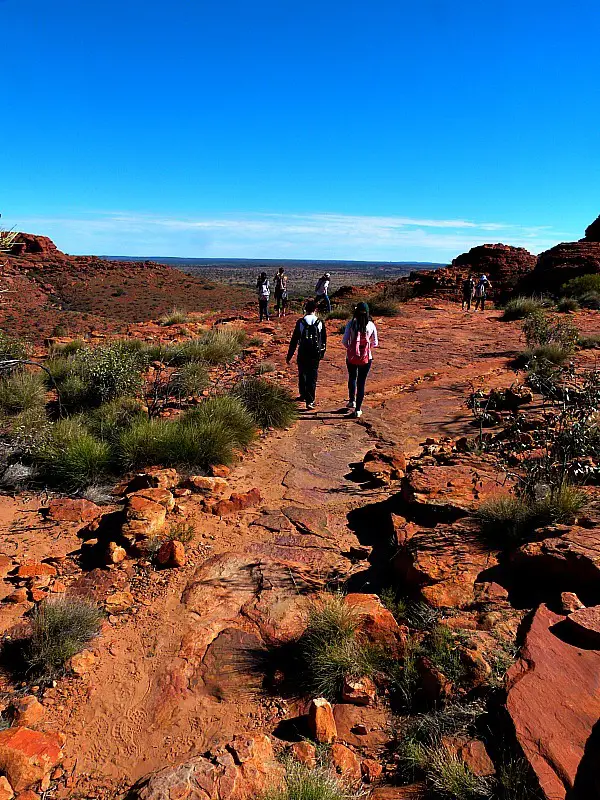 The Ipi Ipi plant also has a less sinister use; it is fantastic at healing cuts and sores as it works as a protective covering, once dry, that aids in speeding up the healing process.
The Ipi Ipi plant also has a less sinister use; it is fantastic at healing cuts and sores as it works as a protective covering, once dry, that aids in speeding up the healing process.
Robbie also pointed out the ghost gum tree. Similar looking to a regular gum tree but with a white coating on the bark which acts as a sunscreen, protecting the tree from the harsh desert sun.
The ghost gum also has the ability to cut off nutrients to its branches when food is scarce; sacrificing its smaller branches to save the whole tree.
These dead branches are a dark brown color and only drop off when the tree is ready to grow new branches again.
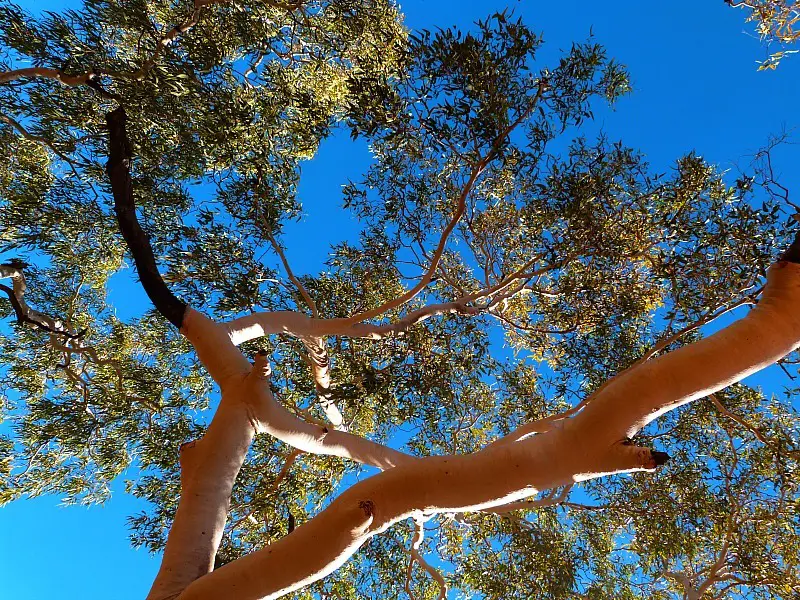 After our Kings Canyon hike, we had a five-hour drive to Alice Springs, and everyone was exhausted. I struggled to keep my eyes open and snoozed on and off during the drive.
After our Kings Canyon hike, we had a five-hour drive to Alice Springs, and everyone was exhausted. I struggled to keep my eyes open and snoozed on and off during the drive.
After a quick stop for our last group photo by the Welcome to Alice Springs sign, we were dropped at our Alice Springs accommodation, the endpoint of our 3 day Uluru tour.
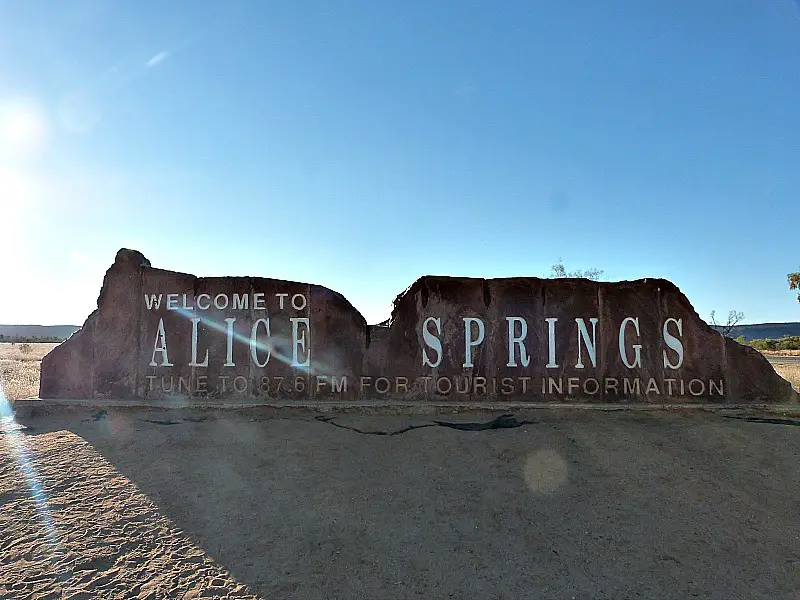 It felt so good to have a shower although all my clothes were still covered in a thin layer of red dust. After freshening up, we met up as a group one last time at the Rock Bar in town for dinner and drinks.
It felt so good to have a shower although all my clothes were still covered in a thin layer of red dust. After freshening up, we met up as a group one last time at the Rock Bar in town for dinner and drinks.
One last goodbye to the awesome people that had shared this special experience with me.
Overall it was a full-on trip with basic accommodation, long days, early starts as well as being physically exhausting.
But despite this, I loved it.
Although it wasn’t a trip that I had always dreamed of doing, I am so glad that I did do it. It gave me a greater appreciation of Australia, and I learned so much more about Australia’s native people and their unique culture.
Sometimes the places that you haven’t given much thought to end up surprising you the most.
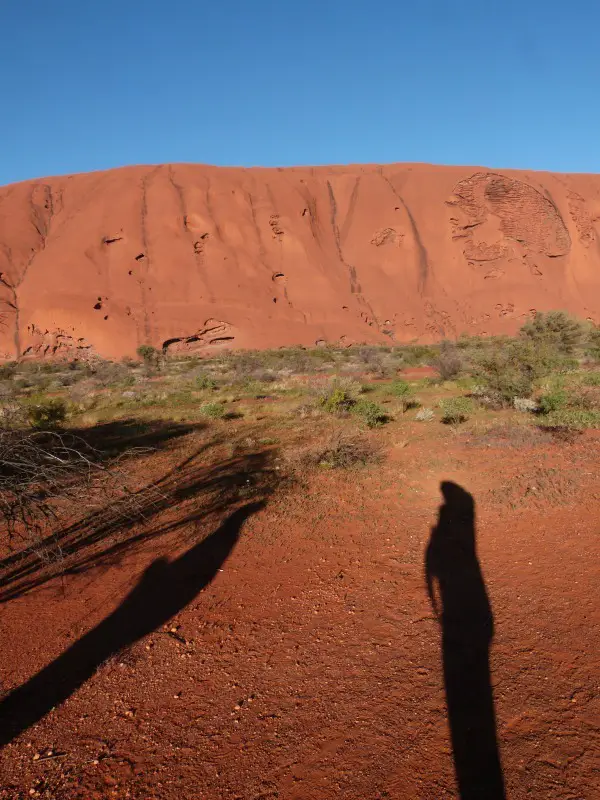
Plan Your Uluru Trip
How to Book Your 3 Day Uluru Tour
Book direct on The Rock Tour website or ring them directly. Tours are currently not available, but you may be able to book now for next year.
My itinerary was written if you are doing the one-way tour from Uluru to Alice Springs, but there are also options to do it starting and finishing in Alice Springs or Uluru, or one way from Alice Springs to Uluru.
For details about how to get to Alice Springs and Uluru, The Rock Tour has a great transport page on their website with everything you need to know.
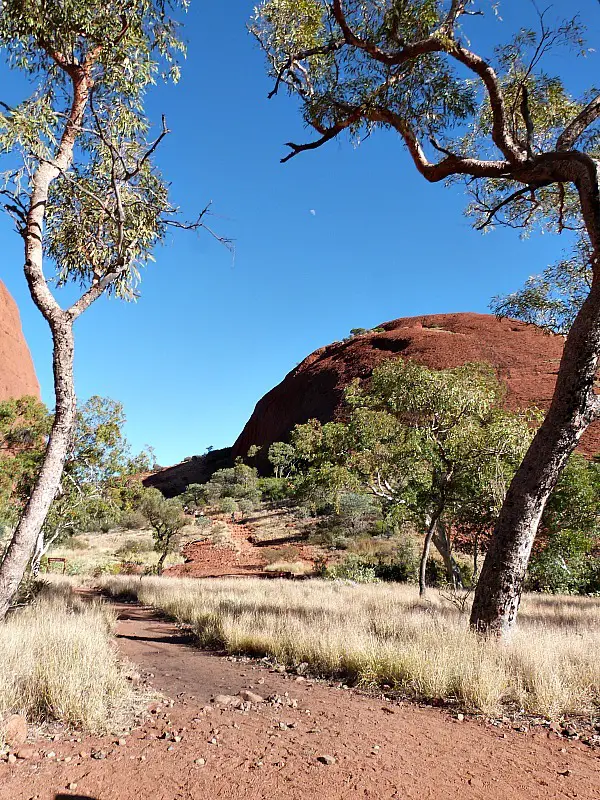
Where To Stay Before and After Your Uluru Tour
Where To Stay in Alice Springs
In Alice Springs, stay at either Alice’s Secret Travellers Inn or Alice Springs YHA if you are looking for budget hostel accommodation where it is easy to meet other travelers. Both offer private and dorm rooms. The Diplomat Motel is a solid budget motel choice right in town.
Excellent mid-range options include Desert Palms Resort, Squeakywindmill Boutique Tent B&B, Alice on Todd Apartments, and Wilmots on Dixon.
To really treat yourself after your Uluru tour, stay at the eco-friendly DoubleTree by Hilton Alice Springs, which has mountain views, and has many amenities onsite like tennis courts, a fitness center, a restaurant, and a heated outdoor pool.
For vacation rentals, stay at either Wild Yam Artstay or Studio Five Apartment.
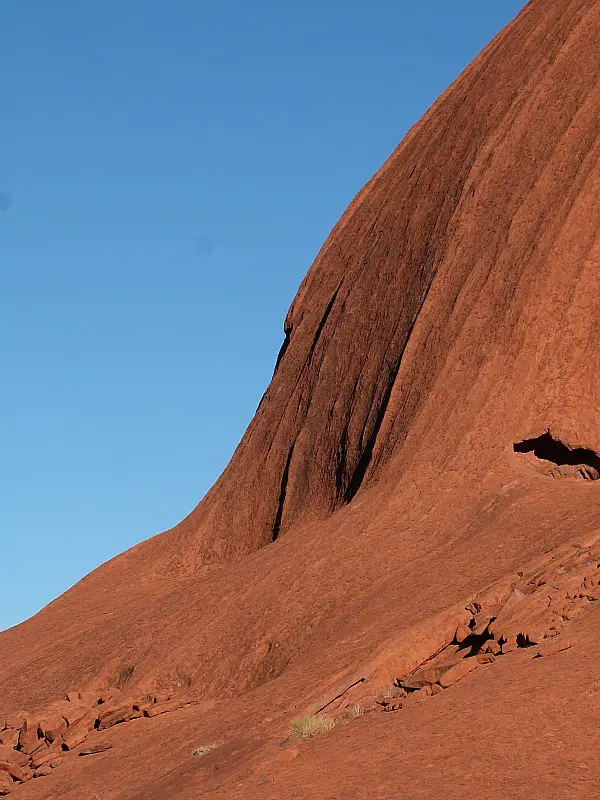
Where To Stay in Uluru
There was a hostel in Uluru but it appears to now be closed unfortunately.
Uluru’s most prestigious accommodation option is definitely Sails in the Desert. This art-filled resort has spacious and luxurious rooms and suites, three restaurants onsite, Uluru views, and a gorgeous pool.
What to Pack for your Uluru Tour
Although the swags are provided, you will need to either bring your own sleeping bag or hire one from The Rock Tour. I recommend bringing your own if you can, as the one provided wasn’t warm enough for winter temps in my opinion. You want one that is lightweight and comfortable down to freezing.
I highly recommend the Osprey Fairview or Farpoint 40L packs – they are the perfect size for a camping trip, are comfortable and durable, and have lots of pockets to organize your gear. Use packing cubes for further organization.
You need to make sure to stay hydrated on hot days in the desert, so pack a CamelBak for hiking, and an insulated water bottle for the rest of the time.
It gets really cold at night so make sure to pack a thermal base layer top, a rain jacket in case it rains, mosquito repellent and sunscreen, a power bank if you want to keep your phone charged, and a head torch.
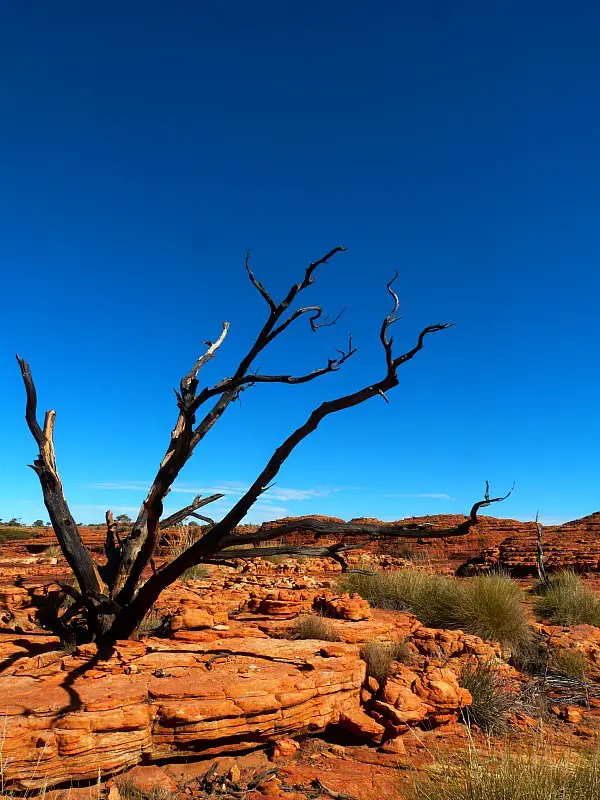
The Best Insurance for Your Uluru Trip
Make sure you get travel and health insurance before your trip – this is very important! Safety Wing is my go-to and they are cheap and easy to claim with.
Safety Wing also allows you to sign up when you are already traveling, unlike a lot of other travel insurance providers.
If you liked this post, check out more of my Australia content:
- Best Things to do in Alice Springs in the Australian Outback
- The Best Two Day Kangaroo Island Itinerary
- The Ultimate Itinerary for 5 Days in Sydney
- The Best Sydney Walks
- How to Spend a Weekend in Cairns and on the Great Barrier Reef
- Experiencing Real Autumn in the Blue Mountains of Australia
- Fitzroy Island: A Tropical Escape on the Great Barrier Reef
- Camping and Hiking in the Grampians: Victoria’s Rocky Mountains
- The Great Ocean Road: Is it Overrated?
- Ultimate Offbeat Summer in Sydney Bucketlist
- How to Spend One Day in Melbourne
PIN IT!
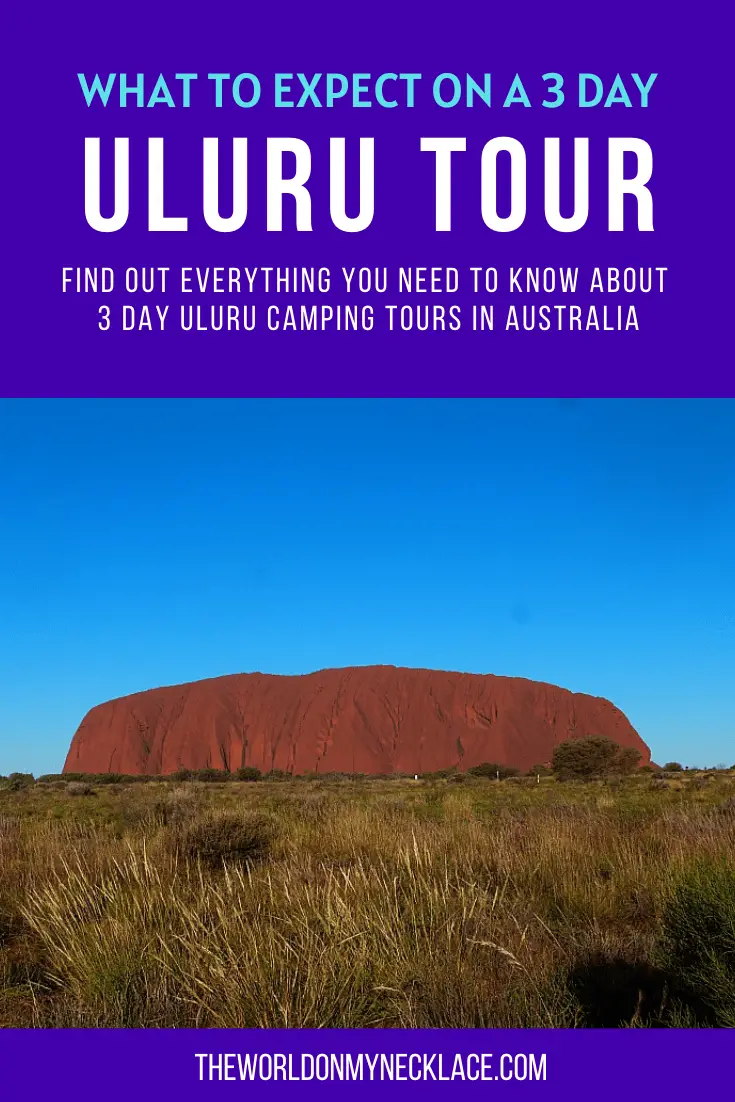
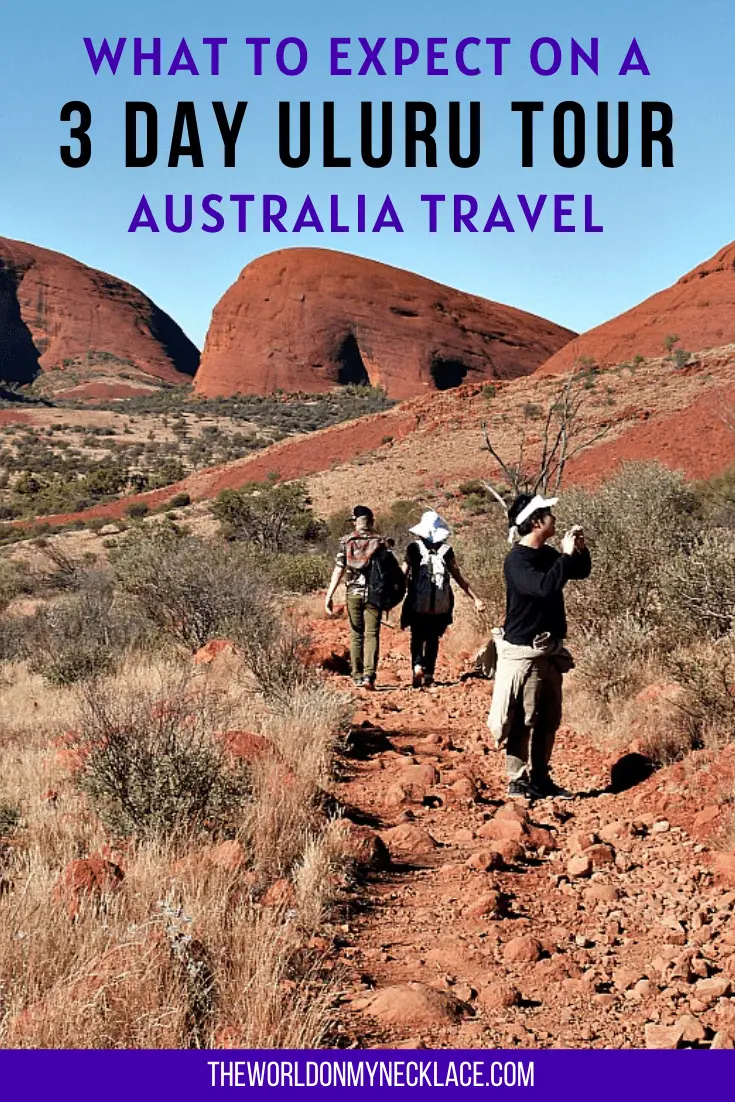
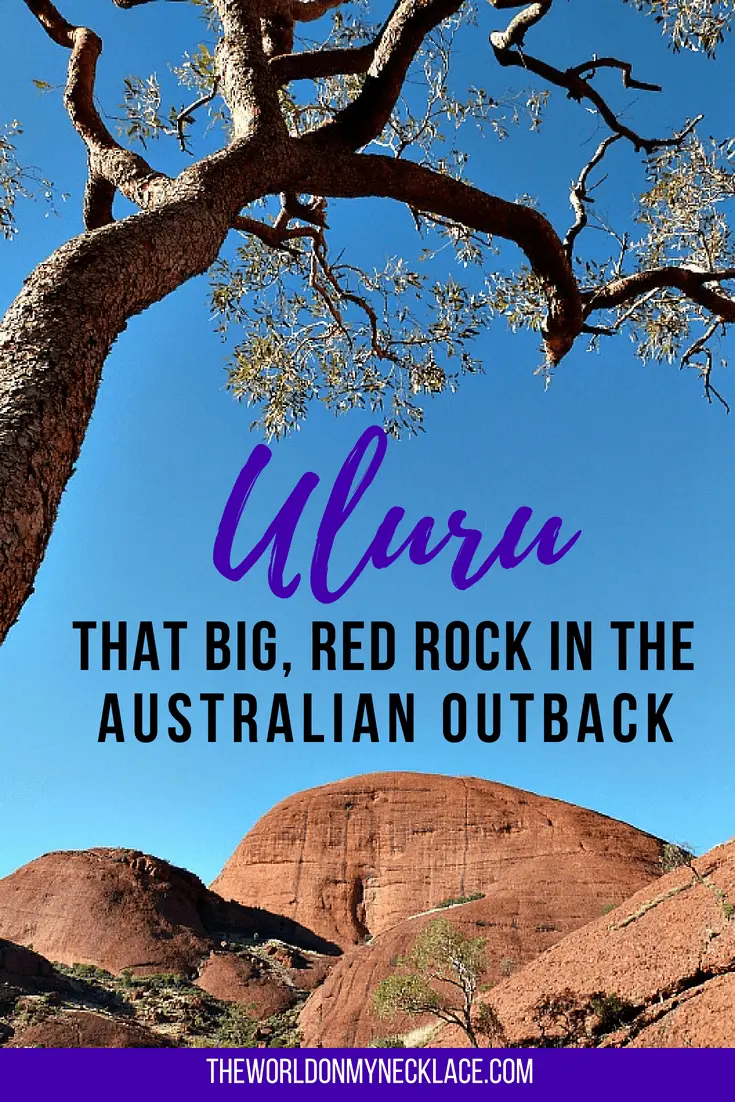

You are one inspiring lady I am amazed of how much travelling you have done in the world and i am so happy that you enjoyed your trip to the red Centre The real unique beauty in Australia is really in the outback.When you are in Western Australia please try seeing the Bungle Bungles.These are sandstone like domes in the middle of the desert .I think they are in an area of 700 square kilometres.By the way,Congratuations on your egagement .If you ever get a chance please do a hiking trail in the Royal national park to the wedding cake rock.My daughter went recently there and really liked it .Wedding cake rock is actually white.Keep up all your lovelly blogs
Thanks Louisa, the red centre is stunning and very unique to Australia.
Love the photos, I missed Uluru last time I was in Australia – may have to go back now!
Thanks Chris. I hope you make it there next tiem. It is pretty far from everything but that is what makes it unique and special
Great piece. I hate when people neglect going to uluru because “it’s just a big rock”, it’s so much more!
You are totally right, I was one of those people until I went there
Sounds like an awesome trip! The pictures of Uluru are gorgeous! I had no idea there was so much to the rock. I figured people just went to get the sunset views and left, but the whole area looks amazing. I’ve got to get to Australia someday soon!
Thanks Amy! I had no idea there was so much to it either, walking around it surprised me how many valleys, caves and waterholes there were. I hope you make it to Australia one day 🙂
I’m not really one for desert landscapes either, but I do think this is something I would like to see someday for myself. Your pictures of Uluru as the sun began to set are so beautiful and I can only imagine how electrifying it must have been to see it in real life!
Thanks guys! It really did blow me away, especially as my expectations were fairly low. The sunset was a definite highlight.
Trip sounded amazing Katie but I don,t think it would be any good for Barb or Rob. So nice that you were able to do this with Robbie as your tour leader. Cheers A Di
Definitely can’t see Mum and Robbie doing it! Rob was a great tour guide, hopefully I can go on his Asia tour when he gets a job there 🙂
So lucky! I really want to go see Uluru, like you said its an icon. Sadly the cost of travelling within Australia has always got in the way! Such a shame that its cheaper to travel to Asia than exploring your own backyard
I definitely feel lucky that I was able to do it when my brother was a tour guide there, although I did still pay for the tour (minus a small family member discount). It wasn’t as expensive as I thought it would be – my return flight from Sydney was $280 and the tour is $355 for 3 days including food. Not too bad. I hope you make it out there someday 🙂
Wow, such beautiful writing and gorgeous pictures! Now after reading this, I can’t wait to visit the red centre. You know you’ve really been affected by a natural wonder when you are reluctant to leave.
Thanks very much Lauren. I am so happy I have inspired you to visit the Red Centre! It really did surprise me how much seeing Uluru moved me. It’s an incredible place.